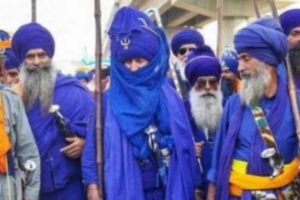
The killing of Lakhbir Singh, a Dalit labourer, near the farmers’ protest site on Haryana-Delhi Singhu border on Friday by a group of Nihang Sikhs has prompted outrage. According to police, members of the Sikh order killed Singh “on suspicion of disrespecting the Sikh holy book”. In a video clip that has gone viral on social media platforms, some Nihangs were seen standing as the man lies on the ground in a pool of blood with his chopped off left hand lying next to him.
Nihang Sarabjit Singh surrendered to the Haryana police and took full responsibility of the killing, sources said.
Who are Nihang Sikhs?
Distinguished by blue robles, antiquated swords and spears, and decorated turbans, Nihang is said to be an order of Sikh “warrior”. A Sikh historian, Dr Balwant Singh Dhillon, however, told Indian Express that the order seems to have its roots from the Sanskrit word ‘nihshank’, which loosely means courageous, unblemished, pure, and carefree. According to Dhillon, the origin of the order can be traced back to Guru Gobind Singh’s Khalsa in 1699 or his son Fateh Singh, who lived from 1699 to 1705. Dhillon says that once upon seeing Fateh’s majestic look -a blue chola and a blue turban – Guru remarked that it will be the dress of the Nihangs.
On a slightly contrasting note, Paramjit Singh Judge, Department of Sociology, Guru Nanak Dev University, told The Print, “there are several theories about the origin of the Nihangs, including the one about their having been a part of the Akaal Sena and later Khalsa Fauj. But unlike the Udasi sect and the Nirmalayas who can be clearly traced back to the Sikh gurus, there is no concrete historical evidence of the origin of the Nihangs.”
How do Nihangs differ from other Sikhs, and Sikh warriors?
While there are two sects of the Khalsa Sikhs – one which wears blue, and other which doesn’t have a dress code – Dhillons says that Nihangs follow the Khalsa code strictly. They do not profess any allegiance to an earthly master. Instead of saffron they hoist a blue Nishan Sahib (flag) atop their shrines, he elaborates.
Nihangs are said to use the slogans ‘chhardi kala’ (forever in high spirits) and ‘tiar bar tiar’ (state of ever preparedness) for unforeseen events.
Nihangs are usually armed with firearms, including traditional ones, wear iron bracelets around their wrists and leather shoes called jangi moze, with a sharp metal fitting at the toe that can be used as a weapon, and wear pagdis much bigger than their heads, according to a report by The Print.
What other incidents have happened recently involving Nihang Sikhs?
On April 12, 2020, a group of Nihang Sikhs from a dera in Patiala drove through multiple barricades around the sabzi mandi in Sanaur, violating curfew norms and brutally attacking an assistant sub-inspector and some others. The ASI’s hand was chopped off with a sword. Seven people, including five attackers, were arrested hours later after an exchange of fire at a gurdwara where the group fled after the 6.15 am incident in Sanaur town.
In July this year, two Nihang Sikhs set afire a statue of slain Prime Minister Rajiv Gandhi in Ludhiana and uploaded a video on social media claiming responsibility for the act. Both were arrested.
What is their current status?
Although the Nihangs constitute a small community and are loosely organised, the order went to Singhu to express solidarity with the protesting farmers. Around a dozen subgroups, which includes factions of Budha Dal, Taruna Dal, are reportedly continuing with the traditional order.
Dr Gurmeet Singh Sidhu, professor-in-charge Guru Gobind Singh Chair at Punjabi University, Patiala, told the Indian Express that the order has now been involved in unethical actions, which was earlier not the case as Nihangs are not known to attack unarmed persons.
Judge, on the Patiala sabzi mandi incident, said that it is surprising that Nihangs attacked the police. “Traditionally, the Nihangs have been pro-establishment.”
Can anyone become a Nihang?
According to Nihang leader, anyone having unshorn hair who follows Sikh traditions, remembers five banis, performs daily rituals at 1 am, morning and evening prayers, can be included in the warrior group. The person willing to become a Nihang will be given robes and weapons similar to Guru Gobindh Singh’s when he founded the Khalsa.




 Driving Naari Programme launched in Chandigarh
Driving Naari Programme launched in Chandigarh






























